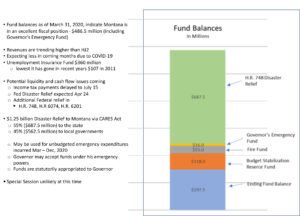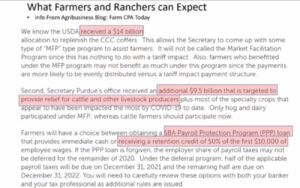Local legislators Nancy Balance (R-HD87) and David Bedey (R-HD86) have prepared their own powerpoint presentation about the CARES Act, where the funds are going and what it means for residents of Montana and especially Ravalli County.
Ballance told the Bitterroot Star that the State of Montana was addressing the issue of unemployment related to the coronavirus epidemic before the CARES Act was passed by Congress. 
“We made unemployment compensation apply to anybody who is being laid off due to COVID-19 whether they were paying into the plan or not,” said Ballance. She said the aim was to keep the employee attached to their job with the potential to return to work after the emergency is over. She said there would also not be the typical waiting period involved for payments to begin.
She said that funds coming in through the CARES Act will allow people receiving unemployment payments to continue to work at another part-time job and it will also add an additional $600 per week to everybody’s payment. Independent contractors will also be compensated. She said these extra funds would help mitigate the low unemployment payments to those who get low wages plus tips.
There are basically three types of loans being made available: the Paycheck Protection Program; the Economic Injury Disaster Loan Advance (EIDL); and EXPRESS Bridge Loan program.
The Paycheck Protection Program is a loan designed to provide a direct incentive for small businesses to keep their workers on the payroll. SBA will forgive loans if all employees are kept on the payroll for eight weeks and the money is used for payroll, rent, mortgage interest, or utilities.
You can apply through any existing SBA 7(a) lender or through any federally insured depository institution, federally insured credit union, and Farm Credit System institution that is participating. Other regulated lenders will be available to make these loans once they are approved and enrolled in the program. You should consult with your local lender as to whether it is participating in the program.
Local lenders have already begun processing PPP loan applications. The Paycheck Protection Program will be available through June 30, 2020.
According to Ballance, this puts the employees in the position that they can choose whether or not to lay off workers or keep them on the job.
The SBA’s Economic Injury Disaster Loan provides vital economic support to small businesses to help overcome the temporary loss of revenue they are experiencing as a result of the COVID-19 pandemic.
This program is for any small business with less than 500 employees (including sole proprietorships, independent contractors and self-employed persons), private non-profit organization or 501(c)(19) veterans organizations affected by COVID-19. Businesses in certain industries may have more than 500 employees if they meet the SBA’s size standards for those industries.
The Economic Injury Disaster Loan advance funds will be made available within days of a successful application, according to the government’s website, and this loan advance will not have to be repaid. However, a number of business owners have reorted that they applied as soon as they heard of this option and still have not received the advance funding.
The Express Bridge Loan Program allows small businesses who currently have a business relationship with an SBA Express Lender to access up to $25,000 quickly. These loans can provide vital economic support to small businesses to help overcome the temporary loss of revenue they are experiencing and can be a term loans or used to bridge the gap while applying for a direct SBA Economic Injury Disaster loan. If a small business has an urgent need for cash while waiting for decision and disbursement on an Economic Injury Disaster Loan, they may qualify for an SBA Express Disaster Bridge Loan.
Under Title VI of the Act, Montana will receive the minimum payment of $1.25 billion, 45% of that is to be allocated to local governments. Ravalli County is slated to receive about $22.5 million.
A summary of federal funding to date may be found at https://leg.mt.gov/content/COVID-19/Montana-COVID-federal-fiscal-bills-summary.pdf